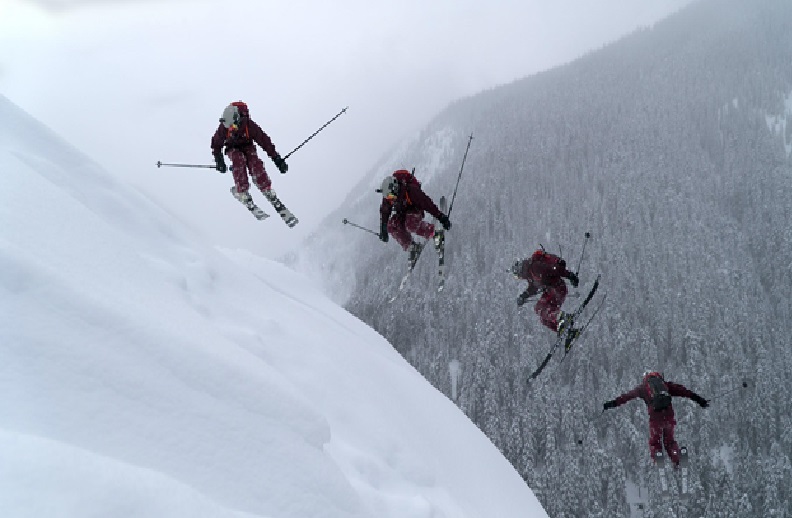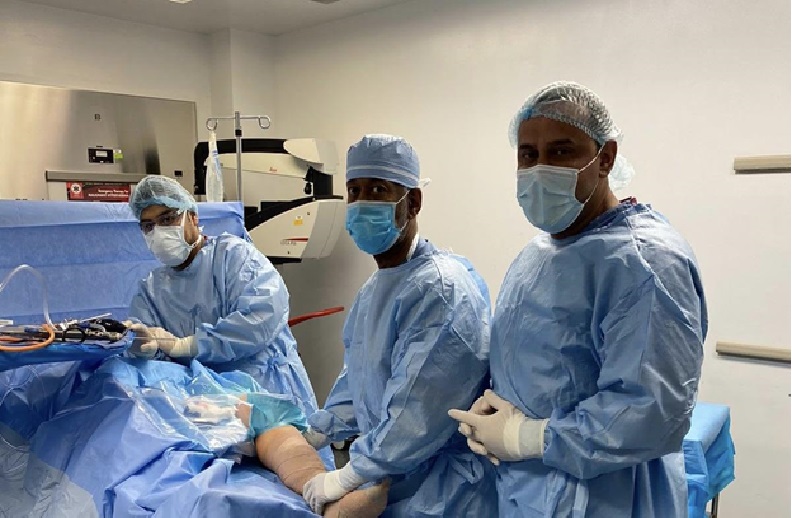Common Winter Sports-Related Injuries and How to Avoid Them

sports wise, the idea of injury prevention may be fleeting and forgettable when signs of winter begin to arrive and they are finally able to indulge in winter sports such as skating, skiing, snowboarding, sledding, ice hockey and others. However, with all the joy that winter sports bring, they also bring risk of unexpected dangers that may result in keeping you off the ice for the season if proper safety precautions and preventive measures are not taken.
According to the U.S. Consumer Product Safety Commission, winter sports-related injuries led to almost 200,000 visits to hospitals, doctor’s offices, and emergency rooms in 2018. This figure includes 76,000 injuries caused by skiing, 53,000 injuries caused by snowboarding, 48,000 injuries caused by ice skating, and 22,000 injuries caused by sledding and tobogganing.
There are many factors that go into winter sports-related injuries, such as muscle overexertion, lack of proper warm ups, and absence of alertness. When enjoying the cold, don’t forget to practice the following winter sports prevention tips so that you can continue to have more enjoyable winter excursions in the snow.
When enduring a winter sport-related injury, it is important to consult with a sports medicine specialist to create a treatment plan that fits your specific needs and concerns, as well as create a recovery plan to help you get back on the ice as soon as possible. At NYC Orthopedic Group, sports medicine orthopedic surgeon, Dr. William L. King specializes in treating injuries affecting the bones, muscles, joints, ligaments, and tendons, which often take a toll during winter sports-related injuries.
Common Winter Sports Injuries

- Head Injury: Concussions are common head injuries that are caused by a mild blow to the head and could potentially result in loss of consciousness. It is vital to check for signs of brain injury after a fall on the ice and have it checked by a medical professional, as severe injuries could appear long after a collision.
Common signs of concussion include:
- Dizziness
- Blurred vision
- Slurred speech
- Loss of consciousness
- Vomiting
- Confusion
- Difficulty recalling significant information
- Shoulder Injury: Because shoulder joints are quite mobile, they are less stable and are at greater risk of dislocation or torn rotator cuffs when an intense collision or crash on ice occurs. Dislocated shoulders also increase risk of injury towards nearby ligaments and muscles, according to the U.S. National Library of Medicine. 1
Winter sports such as skiing, skating, and ice hockey put participants at greater risk of dislocated shoulders due to falling or running into fellow participants. It is recommended to visit a sports medicine specialist when enduring shoulder injury caused by sports timely, as lack of medical attention could prevent further mobility in your shoulder.
- Back/Spine Injury: Back and spinal injuries/pain during the winter may occur from various factors, such as collisions during sports, or caused by inflammation of joints due to the cold. Back and spinal injuries may pose many difficulties towards your everyday life, as the pain from sprains or strains in the the muscles or ligaments of the back can be enough to keep you off your feet for weeks, while a fracture or dislocation towards the spinal cord may lead of partial or full paralysis. Is vital to take precautionary methods before hitting the slopes or engaging in any other winter sports activities. Seniors are especially prone to back pains during the chilly weather, as arthritis and joint inflammation is more prone to increase during the cold.
- Elbow Injury: Elbow injuries may occur from overuse of the elbow, which can lead to damaged tendons, or from the impact of breaking a fall with outstretched arms during a hard landing, which may lead to a fracture in the arm or a dislocated elbow, often resulting in severe pain and swelling. It is best advised to visit a medical professional when these symptoms occur.
- Knee Injury: Knee injury is one of the most common winter sports-related injuries. The knees regularly absorb shock to the body, and this shock becomes intensified during intense and high-impact sports activities that include bending and prolonged pressure on the knees, which may cause wear and tear of the ligaments over time. Increased risk for damage and injury to the knees may occur when sustaining a fall or bad landing on the knees.
Common knee injuries related to winter sports are torn ligaments that surround the knee, torn meniscus (the cartilage around the bones connecting the knee), a fractured kneecap, or dislocated knee. These injuries often require surgery, and could have a lasting effect if not treated properly and correct recovery maintenance is not taken. The NYC Orthopedic Group facility contains trained medical healthcare professionals and orthopedic surgeon, Dr. William L. King, who specialize in the treatment and rehabilitation of sports-related injuries and provide well rounded knowledge and tailored care towards each patient’s unique condition.
- Ankle or Wrist Injury: Ankle injuries are commonly a result of instability on the ice when running, walking, or skiing on uneven surfaces. They may also occur from a twist, roll, fracture, or sprain due to loss of control. Ankle injuries are quite common among snowboarders, so much so that the fracture of the talus bone that surrounds the ankle is known as “snowboarder’s ankle”. Wrist injuries usually occur when bracing a fall, and exposure of the wrist to the force of impact on your body. It is important to follow the PRICE (Protection, Rest, Ice, Compression, and Elevation) Method when injuring the ankle or wrist and provide plenty of rest to those areas so that further injury does not occur. If pain and swelling do not subside after a couple of days, it may be time to visit an orthopedic specialist.
How to Prevent Winter Sports-Related Injuries
- Take Breaks: With adrenaline pumping through your veins in combination with the chilly weather keeping you cool; it may be difficult to tell when your body is experiencing overexertion. Taking regular breaks to rehydrate and give your body a moment to recuperate can go a long way in preventing injuries.
- Warm Up Thoroughly: It’s important to maintain a healthy and active body before participating in any sport, but especially when preparing to hit the ice. Colder temperatures tighten muscles, allowing more room for injury, muscle cramps, and strains. Performing a wide range of warmups, such as arm, leg and back stretches, light cardio, and squats helps to lubricate and loosen muscles and joints.
- Use Protective Gear: Protective gear is vital in preventing even the most severe injuries and is the easiest way to protect yourself. Most importantly, choosing the correct helmet is crucial. Look for a helmet that has a powerful shock absorption layer, full coverage, one that is specifically designed for the sport you are engaging in, and a correct, snug fit around your head. Proper padding and goggles are also useful in preventing injury.
- Maintain Proper Technique: it is important to know proper techniques when engaging in any winter sport. If you are unfamiliar with the sport, try to learn from a qualified instructor to be aware of how to properly maneuver and hold your body when going down the slopes or gliding across ice. A qualified instructor will also provide information on how to break for a fall and in what position to place your body when falling.
- Be Aware of Your Limits: Being aware of your where experience level stands is important in preventing injuries that can be avoided. Take caution in going down difficult slopes that you are not familiar with or attempting tricks that are beyond your ability. It may be fun to experiment, however not when there is serious risk of injury involved.
It is also important to know when to cut the fun at the end of the day, as overexertion of muscles and joints can lead to painful injuries if pushed to the limit.
In the Case of Injury, Seek Proper Medical Attention Timely

In the era of orthopedic and arthroscopic surgery, also known simply as arthroscopy, is a minimally invasive orthopedic procedure used to diagnose and treat joint problems. Orthopedic procedure has become one of the most popular procedures, It involves the use of a narrow scope, called an arthroscope, and specialized surgical tools to access a joint through tiny “keyhole” incisions. In this article, Dr. William L. King, a successful Orthopedic and Clinical Instructor of Orthopedic Surgery Hospital for Joint Diseases of New York also known as NYU Langone Orthopedic Hospital, explores how using Arthroscopic Surgery can be a right option.
While it is important and necessary to follow preventative measures to your full ability, there may be a case where injury occurs. It is crucial to seek proper medical attention timely, before injury worsens. The staff at NYC Orthopedic Group will work to help you get back to a pain-free lifestyle as soon as possible after sustaining an injury. Dr. William L. King is an orthopedic surgeon who specializes in sports medicine, arthroscopy, hand reconstruction and treatment of injuries towards the leg, knee, ankle, shoulder, arm, hand, and wrist as well as lack of joint mobility due to degenerative diseases.
Reach out to NYC Orthopedic Group offices of Dr. William L. King today to discuss arthroscopic diagnosis and treatment options.
Manhattan – Bronx – Queens – Brooklyn – Nassau
Phone: (929) 999-1071
Email: King@NYCOrthopedicGroup.com
Sources
You don't have to live with your pain... Let us help you relieve your pain and improve the quality of your life. Request Appointment today!



 NYC Orthopedic Group
NYC Orthopedic Group